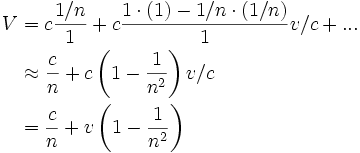Light in moving media
Requisites
Relativistic addition of velocities
Refractive index
Problem
Light moves through a slowly moving medium with refractive index n. That medium moves with a speed v in parallel with the direction of light. What speed will be measured for that light by a rest observer?
Solution
If we have a medium with refractive index n, the speed of light relative to that medium is c/n.
Using relativistic addition of velocities, we get for the rest observer:

But as  , we can expand that expression in terms of
, we can expand that expression in terms of  :
:


The factor  was known as the Fresnel drag coefficient. It is easily measured with interference experiments.
was known as the Fresnel drag coefficient. It is easily measured with interference experiments.
Generalization

This article is issued from Wikiversity - version of the Monday, April 04, 2016. The text is available under the Creative Commons Attribution/Share Alike but additional terms may apply for the media files.